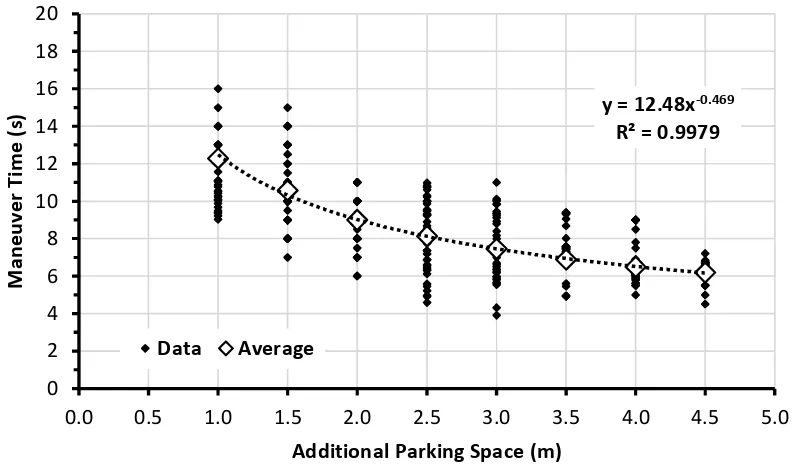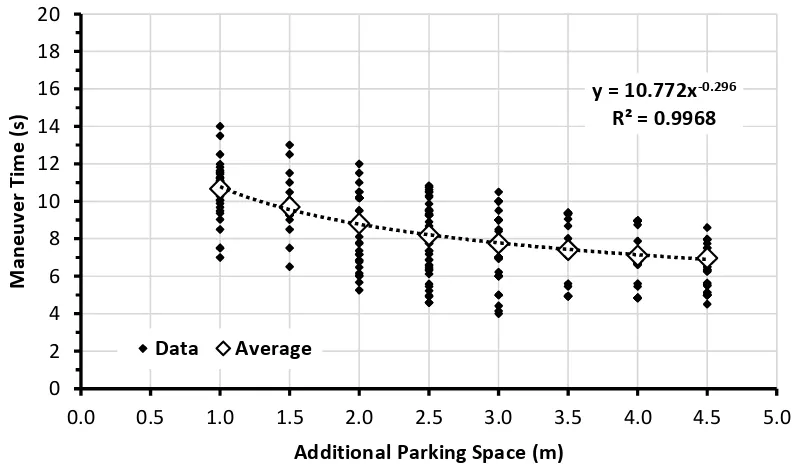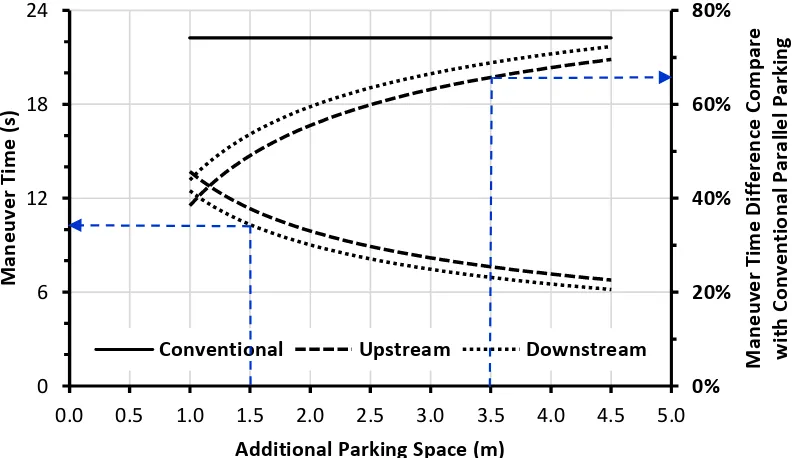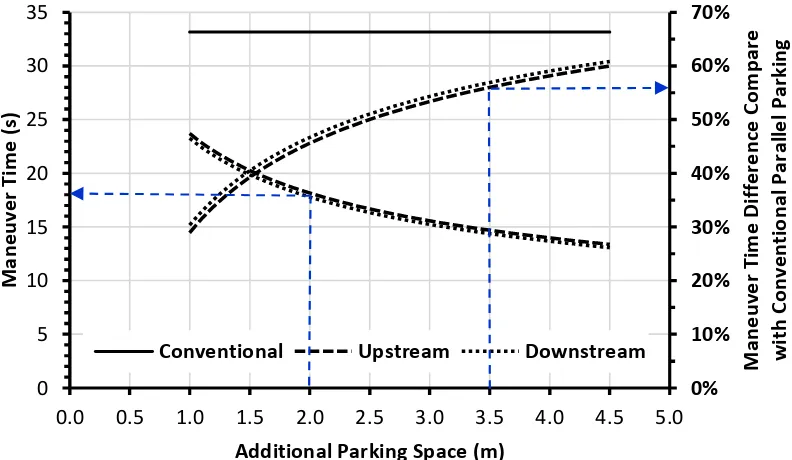1
IMPACT
OF
THE
ADDITIONAL
PARKING
SPACE
ON
PARALLEL
PARKING
MANEUVER
TIME
Rudy Setiawan Civil Engineering Department Faculty of Civil Engineering and Planning
Petra Christian University Jln. Siwalankerto 121-131
Surabaya, Indonesia [email protected]
Abstract
The study reports the effect of additional parking space for the tandem parking upstream stall and downstream stall to reduce parking maneuver time compare with conventional parallel parking maneuver time. The experiments involving 295 students of Petra Christian University. Results indicate that, added one-meter additional parking space could reduce total maneuver time up to 29% for the upstream stall and 31% for the downstream stall, and also reduce 8% income from on-street parking fee, but also will reduce 35% loss due to the delay time caused by parallel parking maneuver.
Keywords: on-street parking; parallel parking; tandem parking system
INTRODUCTION
The availability of the car park is an inevitability for car user and will ease car user, especially when car park location is near by their destination. However, there are car park configurations that will affect the travel time of adjacent traffic flow causing by parking maneuver, specifically conventional parallel on-street parking.
Recently, car manufacturers have added intelligent vehicle parking assist systems to the car due to difficulties in parallel parking (Wolf et al., 2010; Reimer, Mehler, and Coughlin, 2010; Su and Chan, 2017). However, that feature takes a few years to become available for any cars (Cherise Threewitt, 2017). Therefore, it is necessary to find an alternative to minimize parallel parking maneuver time.
One alternative to reduce the delay time of adjacent traffic flow due to parallel parking maneuvers is to use a tandem parking system, both upstream stall and downstream stall (Iowa Department of Transportation Office of Design, 2010). Although the drawbacks of tandem parking system are reduced efficiency the use of parking space and encourages on-street parking (Essex Works, 2009).
2
PARALLEL PARKING
Conventional parallel parking is a parking layout, in which car was parked parallel to the road in line with other parked cars (Figure 1). For few drivers, parallel parking maneuver is considered difficult and is required in test to get the car-driving license in Indonesia. Conventional parallel parking enables the driver to park a car in a smaller space. Reversing approach into the empty parallel parking space allows the driver to take advantage of an empty parking space a little bit longer than the car dimension.
One of the issues that arise from the on-street parallel parking is the maneuver time that affects travel time to the adjacent traffic. Tandem parallel parking both upstream stall and downstream stall, in which two cars were parked with additional parking space between them, the additional parking space could be used to ease entry and exit maneuver (Figure 2 and Figure 3), are an option to reduce delay time causing by maneuver time compare with conventional parallel parking (Iowa Department of Transportation Office of Design, 2010).
Figure 1 Conventional Parallel Parking
Figure 2 Tandem Parking Upstream Stall
3
METHODS
The experiment involving 295 students of Petra Christian University, the car type varies from city car, sedan, Sport Utility Vehicle, Multi-Purpose Vehicle, and Double Cabin. The car dimension (length x width) participate in this experiment was varies from 3,410mm x 1,460mm to 5,255mm x 2,154mm, and the average is 4,148mm x 1,710mm.
In this experiments, the dimension of parking space for the conventional parallel parking is 5,700mm x 2,400mm (stall length x stall width), and aisle width is 2,700mm (Setiawan, Kurniawan, and Tomasoa, 2010). The dimension of parking space for the upstream stall and downstream stall is the same as the conventional parallel parking, with the additional parking space varies between 1.0m up to 4.5m with 0.5m interval.
The reduction of delay time to adjacent traffic causing by parallel maneuver time between conventional parallel parking and tandem parallel parking, compare using the Value of Time (VT). VT for Surabaya City at 2017 is IDR. 27,510 per car per hour, that obtain from the VT for Surabaya City at 2015 (IDR. 24,484) multiplied by interest rate 6% (Faridli and Kartika, 2013).
RESULTS
The average entry and exit maneuver time for the conventional parallel parking are 22.3 secs (SD = 2.7) and 10.9 secs (SD = 1.3) respectively. The entry maneuver time are longer than the exit maneuver time because for the entry maneuver driver need to do it in three steps, first positioning the car, second reversing approach into the parking space, and third adjusting parking position inside the parking space.
4
Figure 4 Upstream Stall Entry Maneuver Time
Figure 5 Downstream Stall Entry Maneuver Time
5
Figure 6 Upstream Stall Exit Maneuver Time
Figure 7 Downstream Stall Exit Maneuver Time
6
Figure 8 Comparison of Entry Maneuver Time
Figure 9 Comparison of Exit Maneuver Time
7
Figure 10 Comparison of Total Maneuver Time
Table 1 illustrated comparison between income from parking fee and loss due to delay time for stall length = 5.7m and varies dimension of additional parking space. Column 1 and column 2 are number of parking space per 100 meters segment of on-street parking, e.g. for additional parking space 1.0m, number of parking space for upstream or downstream = 100/(5.7 + (1.0/2)) = 16.1 parking space.
Table 1 Income from Parking Fee Additional
Income from Parking Fee (IDR/hour)
C U and D C U and D Difference C = Conventional, U and D = Upstream and Downstream
*average between upstream and downstream
8
Table 2 Loss due to Delay Time Additional
Loss due to Delay Time (IDR/hour)
C U and D C U and D Difference C = Conventional, U and D = Upstream and Downstream
*average between upstream and downstream
Based on number of parking space on column 1 and column 2, if parking turn over = 2 and parking fee is fix IDR 5,000 per car, e.g. income from parking fee for upstream or downstream = 2 x 16.1 x 5.000 = IDR 161,290. Column 5 show the difference income from parking fee between conventional parallel parking and upstream/downstream stall for varies additional parking space.
Total maneuver time for conventional and upstream /downstream stall are shown in Table 2 column 1 and column 2 respectively. Column 2 is average total maneuver time between upstream stall and downstream stall, because the value for each maneuver almost the same (Figure 10).
Column 3 and column 4 show the loss due to delay time causing by maneuver time for VT = IDR 27.510/pcu/hour, traffic flow = 1.000 pcu/hour, e.g. loss due to maneuver time for additional parking space 1.0m = (16.1 x 2 x 23.3)/3,600 x 27,510 x 1,000 = IDR 5,741,143/hour. Column 5 show the difference loss due to delay time between conventional parallel parking and upstream/downstream stall for varies additional parking space.
CONCLUSIONS
9
REFERENCES
Cherise Threewitt. 2017. The 8 Best Self-Parking Cars.
Essex Works. 2009. Parking Standards Design and Good Practice.
Faridli, M. M., and Kartika, A. A. G. 2013. Studi Kelayakan Pembangunan Jalan Lingkar Barat Dalam Kota Surabaya. Jurnal Teknik POMITS, 1(1), 1–6.
Iowa Department of Transportation Office of Design. 2010. Parking on Urban Primary Highways Chapter 6C-8.
Reimer, B., Mehler, B., and Coughlin, J. F. 2010. An Evaluation of Driver Reactions to New Vehicle Parking Assist Technologies Developed to Reduce Driver Stress. New England University Transportation Center, 1–26.
Setiawan, R., Kurniawan, W., and Tomasoa, S. H. P. 2010. Dampak Perubahan Dimensi Petak Parkir Terhadap Waktu Manuver Parkir Paralel. In Konferensi Nasional Teknik Sipil (KoNTekS) 4. (Sanur-Bali, 2-3 Juni 2010)
Su, D., and Chan, K. 2017. Compensating for Operational Uncertainty in Man – Machine Systems : A Case Study on Intelligent Vehicle Parking Assist System, 1(September 2015), 1–13. http://doi.org/10.1115/1.4030438
Wolf, C. C., Ocklenburg, S., Ören, B., Becker, C., Hofstätter, A., Bös, C., … Güntürkün, O. 2010. Sex differences in parking are affected by biological and social factors.




